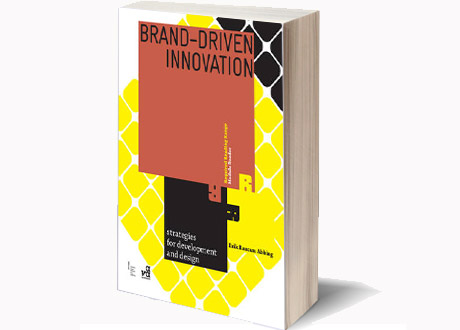By: Haydn Shaughnessy
Even companies that do not invest in design thinking do invest in designing their brand. In a new book, Brand Driven Innovation, Erik Roscam Abbing looks at how brand should be redesigned and how that helps the innovation process.
I had the good fortune this weekend to sit down for an hour or so with Erik Roscam Abbing’s new book: Brand Driven Innovation. In my view it is more than a valuable addition to the design thinking literature, it takes design thinking up a level and provides a novel conceptual framework for managers who want to (or need to) rethink how they relate their corporate and product brands to the innovation process. I’m not convinced by all of Roscam’s arguments but I am convinced he presents a good and valuable framework for managers to work with branding, design and innovation.
The first thing to note before you buy it, is the book is set out as a workbook. It has the argumentation and it has the exercises. It’s not just a read, it’s a practical guide. That means the flow can be interrupted. I prefer more fluidity but this is a book for managers who need to know and need guidance.
The book is organised around six major themes: How branding and innovation are connected; how these are both connected to design (and how these three worlds are converging); how to build a human centred brand; building a brand-driven innovation strategy; how to build a brand-driven design strategy; and how to orchestrate the touchpoints.
Roscam discusses innovation, branding and design in terms of their merger as disciplines. It’s easy to see how that stacks up in some celebrated cases (he uses Innocent Drinks and Icebreaker outdoor wear as his first two case studies and there is no doubt that these are strong brands that have innovated their sectors and have made novel use of design).
His comparison of the terms ‘brand’ and ‘innovation’ makes sense – both are extensively used and carry many meanings. Roscam’s contention is that our approach to both is in transition. For example, brands were previously a sign of ownership for the use, a facade for the company and they were tightly managed and controlled. Today they are more like a vision for the company or a lens through which people can see the company more clearly, or they represent a meaning co-created with users.
Innovation used to be about product, technology and R&D but it is now about value and anything that carries value; it is about creativity and entrepreneurship and it too is about vision, it is a part of the culture of the company.
In brand-driven innovation, he also contends, the innovation begins long before a new idea. It starts back with the process and insights that lead to new ideas. Design meanwhile is the creative process that defines the essence of objects, expressions, services and environments. It too is essential to the value of things.
The innovation begins long before a new idea. It starts back with the process and insights that lead to new ideas.
So you can see brand, innovation and design seem also to be converging around value. Roscam’s way of seeing the innovation process is heavily informed by these points of origin in design and new brand values.
I think though that there is a word missing from the analysis. The missing word is purpose. I personally do not believe that brand acts as a bridge between competing parts of an organisation or between the innovation and design processes, as Roscam seems to suggest. I think an increasing number of designers are on a journey from function to purpose, and see an opportunity to invest their work with a higher meaning (which is the place they have always wanted to be).
At the same time any sensible brand owner should be trying to connect with its customers through a higher purpose – customers are ready for it and some major brands are aware of this, though may not be aware of what value they can derive from design. Design has to help companies to bridge the brand promise and unmet need and the latter of these two is the job of innovation. There’s no question Roscam is on to a great framework for helping managers to understand and better exploit these connections.
By Haydn Shaughnessy
About the author
 Haydn Shaughnessy, senior editor, has worked at the epicentre of innovation in a 25 year career spanning journalism, consultancy and research management. He began his technology career as a manager of application research in broadband, mobile and downstream satellite services and has maintained a continuous production of analysis and intellectual material around innovation since then, having written on Wired Cities, Fibre to the Home, Future Search Engines, and international collaboration. He is an emerging thought leader in systemic innovation building on his PhD research in large scale economic transformations. He was previously a parter at The Conversation Group, the leading global social technologies consultancy where he helped companies such as Alcatel Lucent, Volvo, General Motors, Symbian Foundation, and Unilever adapt to the current transformations in the global digital economy. He has written for the Wall St Journal, Forbes.com, Harvard Business Review, and many newspapers as well as making documentaries for the BBC, Channel 4 and RTE. His consultancy and research work encompasses changing enterprise structures, new business models and long-term trends in attitudes. He is in demand as a speaker on the impact of changing attitudes on business and on gearing innovation to new consumer requirements.
Haydn Shaughnessy, senior editor, has worked at the epicentre of innovation in a 25 year career spanning journalism, consultancy and research management. He began his technology career as a manager of application research in broadband, mobile and downstream satellite services and has maintained a continuous production of analysis and intellectual material around innovation since then, having written on Wired Cities, Fibre to the Home, Future Search Engines, and international collaboration. He is an emerging thought leader in systemic innovation building on his PhD research in large scale economic transformations. He was previously a parter at The Conversation Group, the leading global social technologies consultancy where he helped companies such as Alcatel Lucent, Volvo, General Motors, Symbian Foundation, and Unilever adapt to the current transformations in the global digital economy. He has written for the Wall St Journal, Forbes.com, Harvard Business Review, and many newspapers as well as making documentaries for the BBC, Channel 4 and RTE. His consultancy and research work encompasses changing enterprise structures, new business models and long-term trends in attitudes. He is in demand as a speaker on the impact of changing attitudes on business and on gearing innovation to new consumer requirements.

